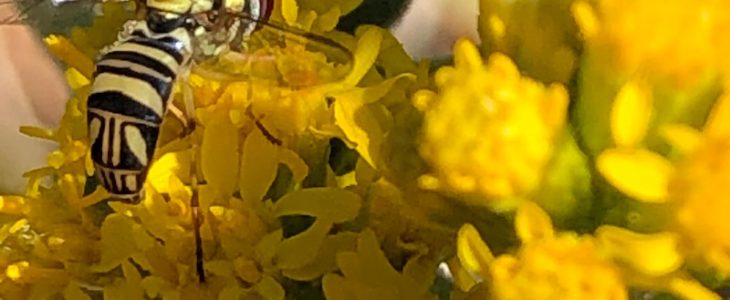
With autumn equinox rapidly approaching we are deep into our natural cycle of summer drought. Many of the plants in the wild are in a dormant state, taking a pause as the soil in most non-wetland areas has dried out completely. Long gone are the spring wild flower displays, the native bulbs are but a memory, hillside grasslands are well into the brown time, coastal scrub areas are mainly showing off their interesting seed heads and the forest understory looks somewhat spare. But if you look beyond those curious dried seed heads and dormant bunch grasses you will see that the season’s pollinators are at work on late blooming shrubs and perennials.
Some of our most satisfying fall blooming perennials also make great additions to the habitat garden. Throughout much of the state below 7500’ California goldenrod Solidago velutina ssp. californica blooms profusely in August and September. On sunny afternoons the patch in my front yard has been so busy with both native and European honey bee activity that I am assured all are making an adequate living. In the case of the European honey bee it looks like there will be plenty to share. California fuchsia and common aster are also adding to the show. The asters are visited by butterflies and bees, the fuchsia keeps the hummingbirds full of buzz and the buckwheats attract an interesting array of tiny native bees, flies and other beneficial insects such as parasitic wasps.
California goldenrod is a member of the aster family. Its flower stems can reach up to four feet in height and are loaded with small golden yellow florets. A patch of goldenrod creates an evocative golden swath. If it is planted up close, you can get a fix on the insect activity which is especially helpful for learning the native bees. A patch planted at a distance becomes a more painterly expression of late summer color. Goldenrod spreads by creeping rootstocks so be sure to give it room. If the plant gets a bit too adventurous it is easy to control by pulling the wandering stems when you cut back the spent flower heads in late fall. California goldenrod grows in full sun to light shade. It needs little to no water, depending upon exposure and where you live (coastal areas being more forgiving).
Provision for insect life in the garden certainly runs the risk of raising an eyebrow. One might ask, why would anyone wish to attract insects? The simple answer is that not all insects are pests. In fact many insects are beneficial to your garden and the urban ecosystem. The obvious examples are the pollinators which are present in a multitude of shapes and sizes from the tiniest gnat, through California’s 1600 native bees, as well as beetles, other flies, bats and birds. Also important to the garden food web are those heroic predatory insects whose appetites keep the numbers of not so beneficial insects down to a tolerable level. The predatory beneficial insects have wonderful names such as minute pirate bug, assassin bug, soldier beetles and aphid lions making them even more of an enticement to learn.
If you are new to the idea of habitat gardening there are some basics to consider. All of us living organisms need food, water, cover and a place to raise young. Starting with the food needed to attract a diversity of insect life, you will need plants that produce pollen and nectar from March (or earlier as the climate warms) through October. The Urban Bee Lab recommends gardeners plant at least 15 – 20 different plant species. Since most of our native plants bloom from March through June the simplest approach to covering the entire range is to be sure you have both early and late bloomers. The rest of the plants will likely fall somewhere in the middle (spring – early summer). Early bloomers include flowering currant (Ribes) and manzanita (Arctostaphylos). The spring wild flowers, gumplant (Grindelia), California lilac (Ceanothus) and the salvias are important during peak bloom from March through June. The late season banquet can be provided by goldenrod, common aster (Symphyotrichum), California fuchsia (Epilobium) and the buckwheats (Eriogonum). For more detailed information on the why, how and additional plant species recommendations check out the Urban Bee Lab’s website http://www.helpabee.org/ or purchase for your reference library the California Bees & Blooms: A Guide for Gardeners and Naturalists.
Happy Equinox!